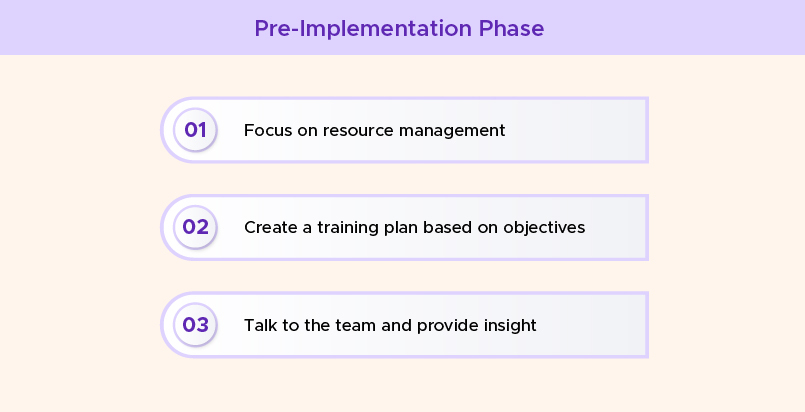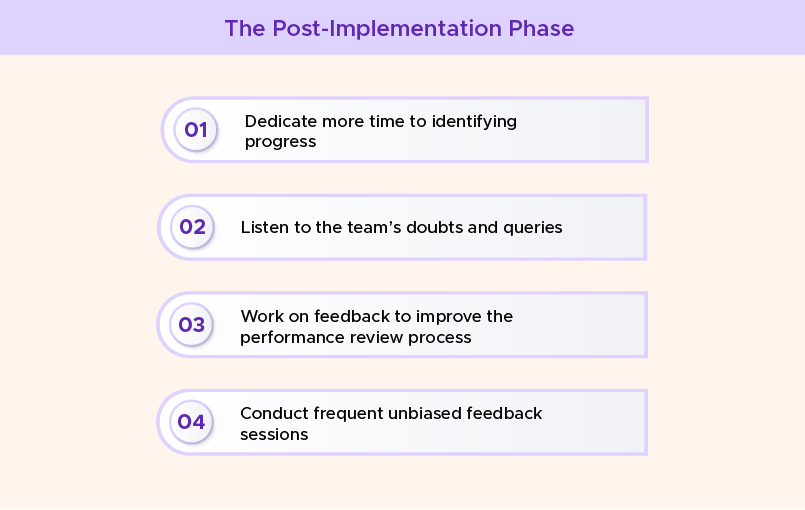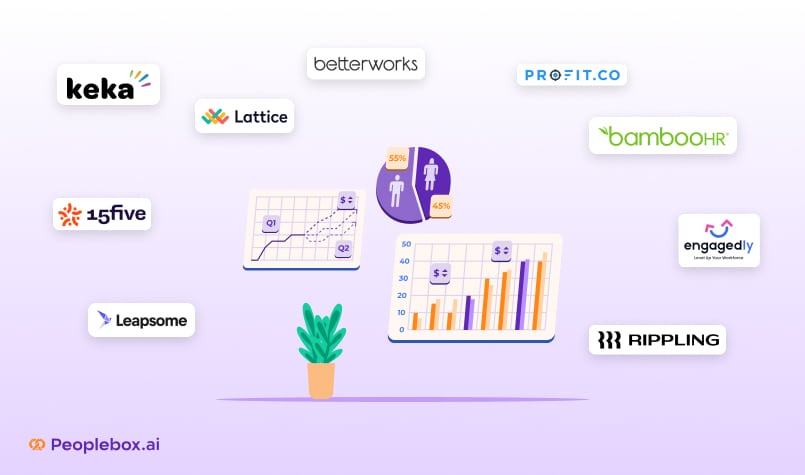In the current scenario, organizations need an agile approach while motivating employee performance and aligning organizational goals with individual objectives. This is possible when they implement continuous performance management for a robust and lean organization.
According to a survey, only 8% of companies believe that their traditional performance review process drives business value. To add, 75% of employees feel the process is unfair, and 95% of the managers are not satisfied with the process.
The traditional system having the formal annual performance review won’t suffice to reap the benefits of performance management.
Traditional annual performance reviews can be dubbed as relics of the industrial age which may not be applicable to companies of today. They were more suited 50 years back when the employee performed a lot of tasks manually.
The one significant difference between traditional performance reviews and continuous performance reviews is that Continuous Performance Review focuses on the present and future, whereas the formal review focuses on past performance.
Especially when you implement OKRs, continuous performance management, followed by regular feedback and cumulative improvement throughout the year, it can boost you and your team members with the constant impetus to grow in an aligned fashion.
Companies like Google, Netflix, and Apple have reported 40% more productivity than an average organization using a continuous performance management framework.
Steps to implement a continuous performance management process.
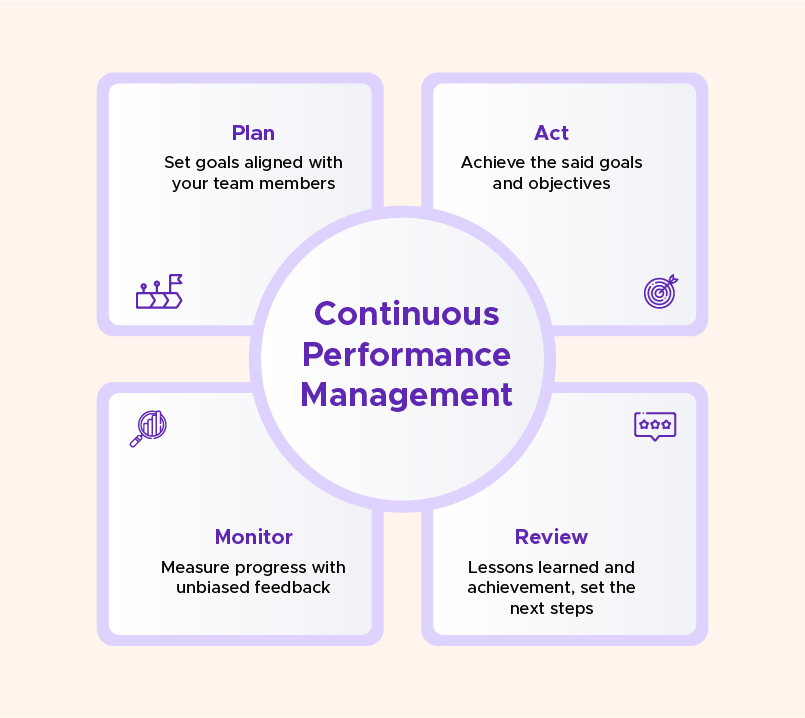
An ongoing performance management program must focus on open communication, leadership, interpersonal relationships, constructive feedback, and teamwork. The basis for all this is mutual trust and recognition in an organization. To implement the process, you need to set a cycle with these four stages –
- Plan – Set goals that are aligned with your team members
- Act – Achieving the said goals and objectives
- Monitor – Measuring progress with unbiased feedback and training opportunities.
- Review – Lessons learned and achievement, and setting up the next steps
The Performance cycle is followed when employees are due for appraisal and next-level skill training.
Pre-implementation phase
Pre implementation phase is crucial for enabling successful implementation of OKRs at levels of the organization. Like all systems, you must go through a resource check and better understand the system in place and how better to implement the new one.
1 Focus on resources.
While setting up the performance metrics, it is vital that you concentrate on the company’s resources and how best to make them understand their job profile and the sequence in which they need to work to achieve the objectives set for them.
This will also help them have a clear idea of how to plan and execute their deliverables. You can also show them how their work aligns with the company’s objectives.
For example, you can create a standard call or email procedure for all the employees who work for the Customer Support Team to have a handy template ready for the client interaction.
You can trace a standard call or email procedure for all the employees who work for the Customer Support Team to have a handy template ready for the client interaction.
This exercise will help the team to know what is expected out of them and provide an insight on outline to plan their goals.
2 Have a training plan
You must create a training plan based on objectives that can help your employees grow, hone their skills, knowledge, and competencies related to working.
The training program can include the measurable standards that a team member must follow and understand the expected outcomes. The program must be designed in a friendly and open discussion format to get feedback and understand the needs of the team members.
The best way to make sure to follow these steps is to have a set training schedule shared with all. The schedule must also have the option to conduct an impromptu training or huddle if and when required.
3 Provide insight about continuous performance management.
Talking to them about continuous performance management can help them have a clear idea about the bridge between their work plan and activities connecting to the goals and performance expectations for review.
Implementation phase
Once the groundwork is laid for the continuous performance management program, you can start setting up the system. This needs to be done gradually and in a logical manner so that the teams are aware and onboard for the changes.
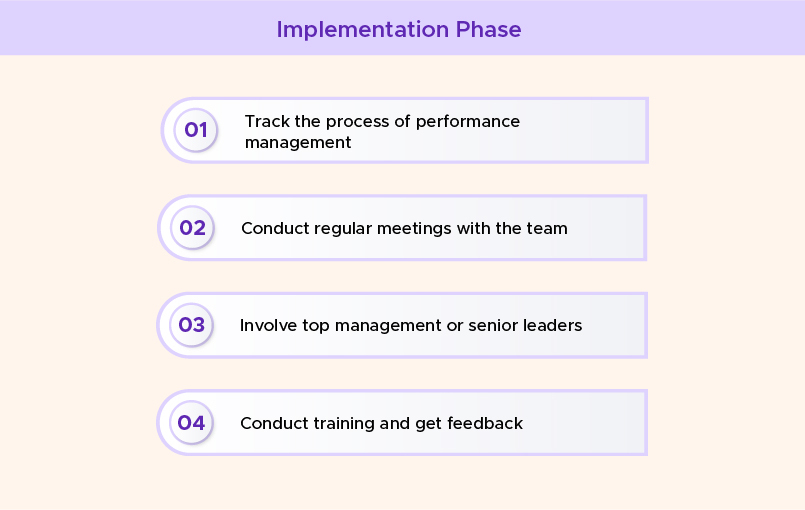
1 Discerning the process of performance management.
Tracking the process via software or a comprehensively prepared spreadsheet can be the easiest way for you to check the progress. Once the process is set, you can check with your team regularly on how it is progressing if there is any need to make changes to any performance management-related tasks that might affect the team’s day-to-day activities.
You can prepare a checklist as per the focus tasks of the team members and maybe ask them to put a tick with the time taken for them, so the team has a better idea. Or if there is something that can be added and must be made, part of the review must be added too.
At least once a week initially, regular meetings may help clear all these doubts and better understand what works and what does not.
2 Conduct regular meetings and briefings on the process.
Regular meetings are at the crux of the Performance implementation process. You must be aware that this is a fluid system that needs timely updates and briefing, unlike a traditional review process that happens as an annual event.
Here you need to have regular interaction with the team to understand and improve the process. Managers can conduct meetings every week or at least every fortnight to align the members’ progress with the goals set for that quarter.
Each member can discuss the challenges they faced or the resolved issues or exchange ideas about how best to work together.
3 Have meaningful discussions on the implementation process.
The continuous Performance Management process only works when there is an open and frank discussion with managers especially.
In many organizations, the managers have already set up an informal system of performance review to track the progress of their members in tandem with the goals being set by the senior leaders.
It has been suggested that in order for employees to understand a change fully, it has to be repeated six or seven times. For this reason, meaningful discussions are critical when transitioning to continuous performance management.
The debate can be conducted with face-to-face meetings, webinars, or team huddles held every week or fortnight.
Here the HR can get the managers involved in the implementation process and train them to cascade this further.
4 Involve the senior leaders.
The involvement of the top management is vital for setting the Continuous Performance Management process. The employees can be motivated to work harder and align themselves with the company’s objectives and goals.
Using research-based evidence to convince the management to be an active member of the process can also give them the impetus to understand why it is better than the annual traditional review system.
With the successful implementation of the new continuous performance management system, top management must get buy-in leading by example to get your workforce on board in a more seamless manner.
The implementation of this system will answer questions regarding how the new process will identify high- and low-performing employees and how promotions, raises and bonuses will be handled. Knowing that these questions have been considered and taken can give leadership a level of confidence in the new system.
5 Conduct training and seek feedback.
Continuous performance management process requires training and it needs to be planned frequently. Giving and receiving feedback are important skills every good manager (and employee) needs to implement continuous performance management.
Managers can be trained to conduct quality performance conversations and deliver meaningful feedback. Managers may need the training to have a more empathic approach with their team, and it can not be achieved with a one-time-only training module.
Feedback means creating the next steps which need to be taken by the team members, including the managers. The intention here is to bring about behavioral change with extra training, mentoring, or any such skill that brings about better growth.
The feedback should be given and accepted in a format that both parties involved must understand what went wrong, and what are the next steps to course correct, also the expectation from them going forward.
6 Reiterate the training process.
Communicating change and seeing its progress is a continuous process. You can not expect to see results at the initial stages.
You may keep reiterating the process at least six to seven times. Having an effective and transparent communication process helps reaffirm the changes, and resolving any doubts or queries regarding the review process will help you assert it better.
Reiteration of the training process clarifies post-implementation for the employees and motivates them to work towards their goals.
Post-implementation phase
Post-implementation checks are the most critical phase, as you may have to dedicate more time to check what is working and what is not. This will require a sharp eye and regular updates or follow ups about the system.
7 Be present constantly as a guide and sounding board.
Post-implementation checks are the most critical phase, as you may have to dedicate more time to check what is working and what is not. This will require a sharp eye and regular updates or follow ups about the system.
8 Be present constantly as a guide and sounding board.
After reiterating the continuous performance management process, the management will have to stop and listen with an open mind to what your team is trying to convey to you with the doubts or queries they are raising. It will help you fine-tune the process better if every manager becomes a sounding board to the team for a fruitful outcome for all.
9 Address the issues and repeat the cyclic process.
With the feedback thus collected, you can make the changes or improve upon the performance review pointers at every stage. This will help you create a more robust performance review process best suited for your company’s culture.
Having a free and open discussion about the issues faced by everyone can help the organization get a better view of the lags. Addressing these issues at every meeting and resolving them immediately can help you improve your approach to this system.
Continuous performance management involves a cyclic process due to its fluid nature and this helps in resolving the issues in a regular manner.The intention for this is to streamline and make it easier for all to follow.
10 Feedbacks need to be frequent and timely.
Every employee is looking for a career advance and skill development opportunity when they become part of an organization. With frequent unbiased feedback and open communication, you can help them achieve their personal goals by aligning them with their objectives.
You can have 1:1 check-ins with them, mark their progress and help them overcome any difficulties so that talent management is done in the best way forward for all.
In a continuous performance management process, feedback is immediate and future-focused. This makes feedback more relevant when shared by a manager and more actionable when received by an employee.
Critical Enablers for implementing continuous performance management
A healthy functioning and a steadily implemented performance management process that enables objective analysis can also deliver a complete bottom-line result.
A continuous performance management process will make your employees take responsibility for their performance and achieve better than expected results.
When you design this process, you must keep in mind how your organization or team functions. Your organization’s culture will be a crucial indicator for following the continuous performance management process.
1 Envision the process of Continuous performance management
It is ideal for researching and formulating continuous performance management, including the stakeholders and decision-makers, and defining an objective and key results expected from it.
Then the critical implementation process can be piloted with a small project and then extended gradually to other projects to achieve better results.
2 Focus on company vision while goal-setting
The success of continuous performance management depends on analyzing the expected outcomes achieved by defining OKRs and considering factors that can reinforce positive performance.
The best practice is to frame goals at all levels promoting maximum employee engagement and adapting the organization.
Working backward and setting ambitious goals can help organizations to thrive during turbulent market scenarios.
3 Goal alignment and Employee motivation
Employees get motivated when management involves them in setting goals that propel them to work towards the vision. Aligning goals to team and employees will instill a sense of inclusion and cultivate suitable buy-ins from top management.
1 Effective feedback process for staff and managers
“Educating your workforce on how to share meaningful feedback and manage goals/objectives is critical when transitioning from traditional performance management to continuous,”
-Harrison Kim ,Pavestep.
It is ideal to have a well-defined feedback process with the right tools to help the management record and redefine the process. The feedback process is crucial as it is the core element for a successful performance management process.
Feedback must be based on observations, the impact due to non-compliance, and suggesting steps to derive positive outcomes. Feedbacks can never be monologue and incomplete without suggestions and next steps.
2 Adapt to the performance management framework
The performance management framework can be designed based on knowledge requirements at all levels of the organization, leadership skills, the functional skills and observable behaviours like trust, approachability and ownership.
3 Choosing a versatile continuous performance management software
The performance management software is an ideal tool to bridge the gap between the traditional approach and the continuous performance management approach.
It also needs to integrate the employee development and map the performance management framework with the competency levels.
It can adapt to volatility at all levels and be easily integrated with the existing tools used by different departments.
Conclusion
To implement an ongoing performance management strategy, we need to have participative leadership, a two-way effective communication process, a medium for constructive feedback, and more avenues for teamwork, as discussed above
“Like so many company processes, when a company is doing “well” then the processes are exactly the right ones and magical. When a company is not doing so “well” then every process is either a symptom or the cause of the situation,”
Says Steven Sinofsky, Microsoft’s Ex-President for the Windows division, in a post about the challenges of performance management for large organizations
Sinofsky also encourages leaders to identify and create your organization’s unique culture so that implementing continuous performance becomes a part of the company’s DNA.
With the Continuous Performance Management process, you can rest assured to have an inspired workforce that genuinely wants to contribute to the growth of your organization.


